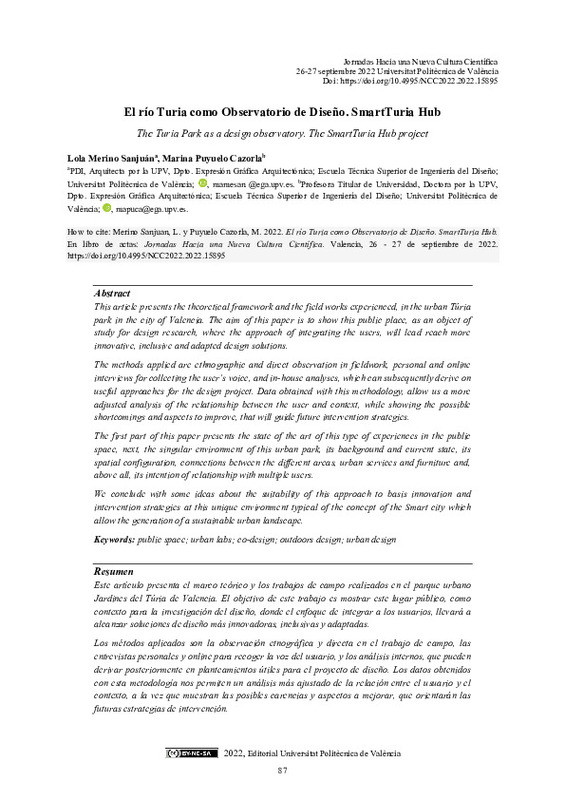JavaScript is disabled for your browser. Some features of this site may not work without it.
Buscar en RiuNet
Listar
Mi cuenta
Estadísticas
Ayuda RiuNet
Admin. UPV
El río Turia como Observatorio de Diseño. SmartTuria Hub
Mostrar el registro sencillo del ítem
Ficheros en el ítem
| dc.contributor.author | Merino Sanjuán, Lola
|
es_ES |
| dc.contributor.author | Puyuelo Cazorla, Marina
|
es_ES |
| dc.date.accessioned | 2022-11-28T09:06:43Z | |
| dc.date.available | 2022-11-28T09:06:43Z | |
| dc.date.issued | 2022-11-15 | |
| dc.identifier.isbn | 9788413960357 | |
| dc.identifier.uri | http://hdl.handle.net/10251/190239 | |
| dc.description.abstract | [EN] This article presents the theoretical framework and the field works experienced, in the urban Túria park in the city of Valencia. The aim of this paper is to show this public place, as an object of study for design research, where the approach of integrating the users, will lead reach more innovative, inclusive and adapted design solutions. The methods applied are ethnographic and direct observation in fieldwork, personal and online interviews for collecting the user’s voice, and in-house analyses, which can subsequently derive on useful approaches for the design project. Data obtained with this methodology, allow us a more adjusted analysis of the relationship between the user and context, while showing the possible shortcomings and aspects to improve, that will guide future intervention strategies. The first part of this paper presents the state of the art of this type of experiences in the public space, next, the singular environment of this urban park, its background and current state, its spatial configuration, connections between the different areas, urban services and furniture and, above all, its intention of relationship with multiple users. We conclude with some ideas about the suitability of this approach to basis innovation and intervention strategies at this unique environment typical of the concept of the Smart city which allow the generation of a sustainable urban landscape. | es_ES |
| dc.description.abstract | [ES] Este artículo presenta el marco teórico y los trabajos de campo realizados en el parque urbano Jardines del Túria de Valencia. El objetivo de este trabajo es mostrar este lugar público, como contexto para la investigación del diseño, donde el enfoque de integrar a los usuarios, llevará a alcanzar soluciones de diseño más innovadoras, inclusivas y adaptadas. Los métodos aplicados son la observación etnográfica y directa en el trabajo de campo, las entrevistas personales y online para recoger la voz del usuario, y los análisis internos, que pueden derivar posteriormente en planteamientos útiles para el proyecto de diseño. Los datos obtenidos con esta metodología nos permiten un análisis más ajustado de la relación entre el usuario y el contexto, a la vez que muestran las posibles carencias y aspectos a mejorar, que orientarán las futuras estrategias de intervención. En la primera parte de este trabajo se presenta el estado del arte de este tipo de experiencias en el espacio público, a continuación, las características de este parque urbano como entorno singular: sus antecedentes y estado actual, su configuración espacial, las conexiones entre las diferentes áreas, los servicios disponibles y el mobiliario urbano y, sobre todo, su relación con múltiples usuarios. Concluimos con algunas ideas sobre la idoneidad de este enfoque para fundamentar estrategias de innovación e intervención en este singular entorno, propio del concepto de Smart city y que permiten generar un paisaje urbano sostenible. | es_ES |
| dc.format.extent | 9 | es_ES |
| dc.language | Español | es_ES |
| dc.publisher | Editorial Universitat Politècnica de València | es_ES |
| dc.relation.ispartof | LIBRO DE ACTAS. Jornadas Hacia una Nueva Cultura Científica | |
| dc.rights | Reconocimiento - No comercial - Compartir igual (by-nc-sa) | es_ES |
| dc.subject | Public space | es_ES |
| dc.subject | Urban labs | es_ES |
| dc.subject | Co-design | es_ES |
| dc.subject | Outdoors design | es_ES |
| dc.subject | Urban design | es_ES |
| dc.subject | Espacio público | es_ES |
| dc.subject | Laboratorios urbanos | es_ES |
| dc.subject | Co-diseño | es_ES |
| dc.subject | Diseño urbano | es_ES |
| dc.title | El río Turia como Observatorio de Diseño. SmartTuria Hub | es_ES |
| dc.title.alternative | The Turia Park as a design observatory. The SmartTuria Hub project | es_ES |
| dc.type | Capítulo de libro | es_ES |
| dc.type | Comunicación en congreso | es_ES |
| dc.identifier.doi | 10.4995/NCC2022.2022.15895 | |
| dc.rights.accessRights | Abierto | es_ES |
| dc.contributor.affiliation | Universitat Politècnica de València. Departamento de Expresión Gráfica Arquitectónica - Departament d'Expressió Gràfica Arquitectònica | es_ES |
| dc.contributor.affiliation | Universitat Politècnica de València. Escuela Técnica Superior de Ingeniería del Diseño - Escola Tècnica Superior d'Enginyeria del Disseny | es_ES |
| dc.description.bibliographicCitation | Merino Sanjuán, L.; Puyuelo Cazorla, M. (2022). El río Turia como Observatorio de Diseño. SmartTuria Hub. En LIBRO DE ACTAS. Jornadas Hacia una Nueva Cultura Científica. Editorial Universitat Politècnica de València. 87-95. https://doi.org/10.4995/NCC2022.2022.15895 | es_ES |
| dc.description.accrualMethod | OCS | es_ES |
| dc.relation.conferencename | 1as Jornadas Hacia una Nueva Cultura Científica | es_ES |
| dc.relation.conferencedate | Septiembre 26-27, 2022 | es_ES |
| dc.relation.conferenceplace | Valencia, España | es_ES |
| dc.relation.publisherversion | http://ocs.editorial.upv.es/index.php/NCC/NCC2022/paper/view/15895 | es_ES |
| dc.description.upvformatpinicio | 87 | es_ES |
| dc.description.upvformatpfin | 95 | es_ES |
| dc.type.version | info:eu-repo/semantics/publishedVersion | es_ES |
| dc.relation.pasarela | OCS\15895 | es_ES |








